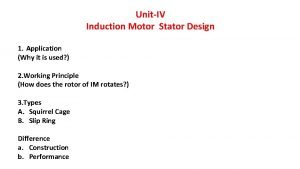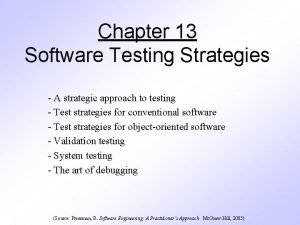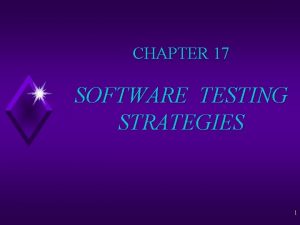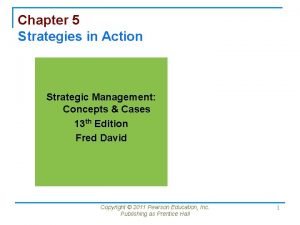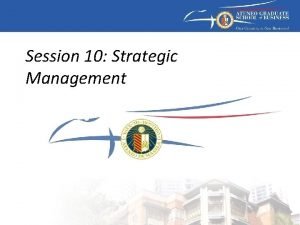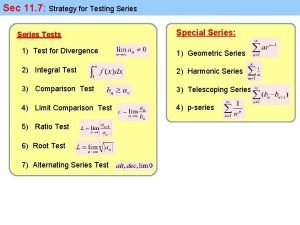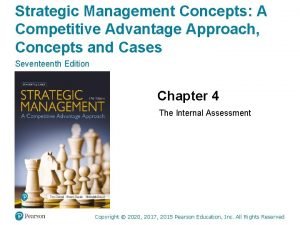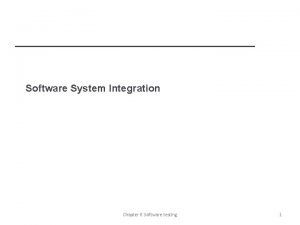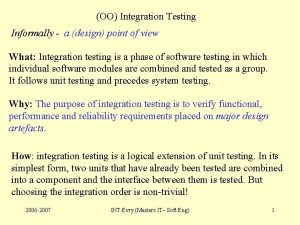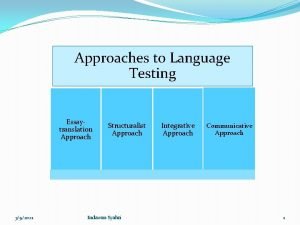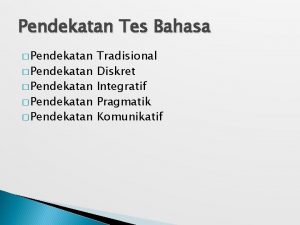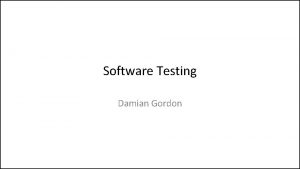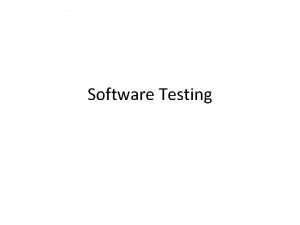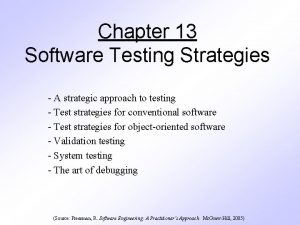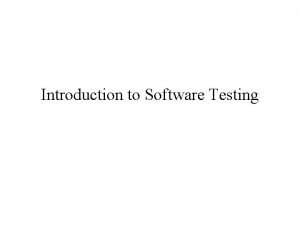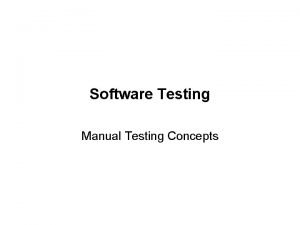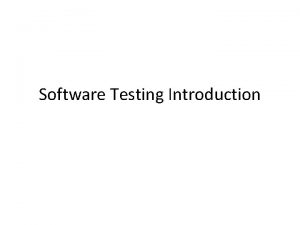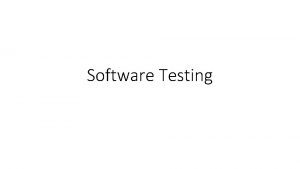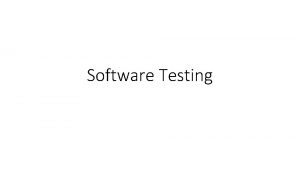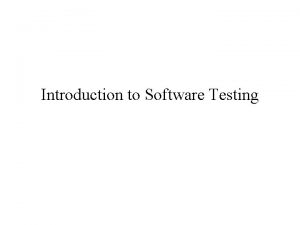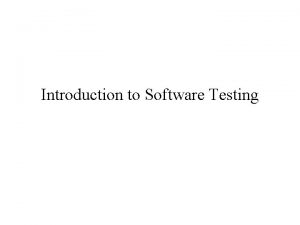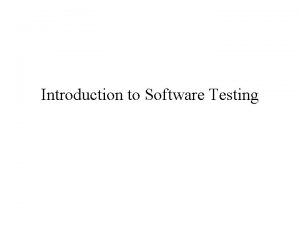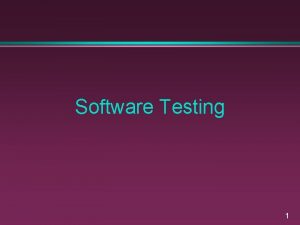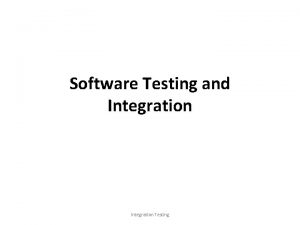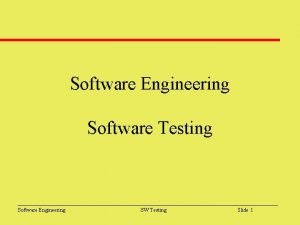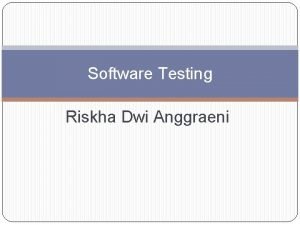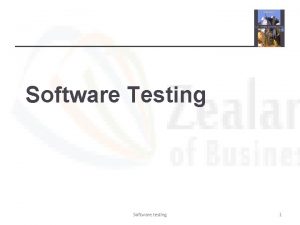UNITIV TESTING STRATEGIES A STRATEGIC APPROACH TO SOFTWARE





























![SOFTWARE TESTING FUNDAMENTALS Testability- “Software testability is simply how easily [a computer program] can SOFTWARE TESTING FUNDAMENTALS Testability- “Software testability is simply how easily [a computer program] can](https://slidetodoc.com/presentation_image_h2/59efbe06e3e008d832c58402943fd7fb/image-30.jpg)




















- Slides: 50

UNIT-IV TESTING STRATEGIES

A STRATEGIC APPROACH TO SOFTWARE TESTING • • • ü Testing is a set of activities that can be planned in advance and conducted systematically. To perform effective testing, you should conduct effective technical reviews. By doing this, many errors will be eliminated before testing commences. Testing begins at the component level and works “outward” toward the integration of the entire computer-based system. Different testing techniques are appropriate for different software engineering approaches and at different points in time. Testing is conducted by the developer of the software and (for large projects) an independent test group. Testing and debugging are different activities, but debugging must be accommodated in any testing strategy for software testing must accommodate low-level tests that are necessary to verify that a small source code segment has been correctly implemented as well as high-level tests that validate major system functions against customer requirements

A STRATEGIC APPROACH TO SOFTWARE TESTING § Verification and Validation Verification refers to the set of tasks that ensure that software correctly implements a specific function. • Validation refers to a different set of tasks that ensure that the software that has been built is traceable to customer requirements. -Verification: “Are we building the product right? ” -Validation: “Are we building the right product? ” - SQA activities: technical reviews, quality and configuration audits, performance monitoring, simulation, feasibility study, documentation review, database review, algorithm analysis, development testing, usability testing, qualification testing, acceptance testing, and installation testing. •

§ Organizing for Software Testing • builder treads lightly, designing and executing tests that will demonstrate that the program works, rather than uncovering errors. • Unfortunately, errors will be present. And, if the software engineer doesn’t find them, the customer will! - misconceptions (1) that the developer of software should do no testing at all, (2) that the software should be “tossed over the wall” to strangers who will test it mercilessly, (3) that testers get involved with the project only when the testing steps are about to begin. Each of these statements is incorrect. - The software developer is always responsible for testing the individual units (components) of the program, ensuring that each performs the function or exhibits the behavior for which it was designed. In many cases, the developer also conducts integration testing - role of an independent test group (ITG) is to remove the inherent problems associated with letting the builder test the thing that has been built. Independent testing removes the conflict of interest that may otherwise be present. After all, ITG personnel are paid to find errors.

A STRATEGIC APPROACH TO SOFTWARE TESTING § Software Testing Strategy—The Big Picture - A strategy for software testing may also be viewed in the context of the spiral (Figure 17. 1). - Unit testing begins at the vortex of the spiral and concentrates on each unit (e. g. , component, class, or Web. App content object) of the software as implemented in source code. - Testing progresses by moving outward along the spiral to integration testing, where the focus is on design and the construction of the software architecture. - validation testing, where requirements established as part of requirements modeling are validated against the software that has been constructed. - system testing, where the software and other system elements are tested as a whole. To test computer software, you spiral out in a clockwise direction along streamlines that broaden the scope of testing with each turn.



• tests focus on each component individually, ensuring that it functions properly as a unit. Hence, the name unit testing. • exercise specific paths in a component’s control structure to ensure complete coverage and maximum error detection. • After the software has been integrated (constructed), a set of high-order tests is conducted. Validation criteria (established during requirements analysis) must be evaluated. Validation testing provides final assurance that software meets all informational, functional, behavioral, and performance requirements. • System testing verifies that all elements mesh properly and that overall system function/performance is achieved.

§ Criteria for Completion of Testing - “When are we done testing—how do we know that we’ve tested enough? ” Sadly, there is no definitive answer to this question. - “You’re never done testing; the burden simply shifts from you (the software engineer) to the end user. ” Every time the user executes a computer program, the program is being tested. - “You’re done testing when you run out of time or you run out of money. ” - The cleanroom software engineering approach suggests statistical use techniques that execute a series of tests derived from a statistical sample of all possible program executions by all users from a targeted population

STRATEGIC ISSUES software testing strategy will succeed when software testers: • Specify product requirements in a proven manner long before testing commences. • State testing objectives explicitly. • Understand the users of the software and develop a profile for each user category. • Develop a testing plan that emphasizes “rapid cycle testing. ” • Conduct technical reviews to assess the test strategy and test cases them self. • Develop a continuous improvement approach for the testing process.

TEST STRATEGIES FOR CONVENTIONAL SOFTWARE Ø Unit Testing - - Unit testing focuses verification effort on the smallest unit of software design— the software component or module. Using the component-level design description as a guide, important control paths are tested to uncover errors within the boundary of the module. unit test focuses on the internal processing logic and data structures within the boundaries of a component

• Unit-test considerations - The module interface is tested to ensure that information properly flows into and out of the program unit under test. - Local data structures are examined to ensure that data stored temporarily maintains its integrity during all steps in an algorithm’s execution. - All independent paths through the control structure are exercised to ensure that all statements in a module have been executed at least once. - Boundary conditions are tested to ensure that the module operates properly at boundaries established to limit or restrict processing. - all error-handling paths are tested

TEST STRATEGIES FOR CONVENTIONAL SOFTWARE § Unit-test procedures -a driver is nothing more than a “main program” that accepts test case data, passes such - - data to the component (to be tested), and prints relevant results. Stubs serve to replace modules that are subordinate (invoked by) the component to be tested. A stub or “dummy subprogram” uses the subordinate module’s interface, may do minimal data manipulation, prints verification of entry, and returns control to the module undergoing testing. Unit testing is simplified when a component with high cohesion is designed. When only one function is addressed by a component

TEST STRATEGIES FOR CONVENTIONAL SOFTWARE Ø Integration Testing - - “If they all work individually, why do you doubt that they’ll work when we put them together? ” The problem, of course, is “putting them together”— interfacing. Data can be lost across an interface; one component can have an inadvertent, adverse effect on another; sub functions, when combined, may not produce the desired major function. objective is to take unit-tested components and build a program structure that has been dictated by design. The program is constructed and tested in small increments, where errors are easier to isolate and correct; interfaces are more likely to be tested completely.

1. Top-down • Modules are integrated by moving downward through the control hierarchy, beginning with the main control module (main program). • Modules subordinate (and ultimately subordinate) to the main control module are incorporated into the structure in either a depth-first or breadth-first manner. • depth-first integration integrates all components on a major control path of the program structure. • Breadth-first integration incorporates all components directly subordinate at each level, moving across the structure horizontally. • The top-down integration strategy verifies major control or decision points early in the test process

TEST STRATEGIES FOR CONVENTIONAL SOFTWARE 2. Bottom-up integration -begins construction and testing with atomic modules (i. e. , components at the lowest levels in the program structure). -Because components are integrated from the bottom up, the functionality provided by components subordinate to a given level is always available. 1. Low-level components are combined into clusters (sometimes called builds) that perform a specific software subfunction. 2. A driver (a control program for testing) is written to coordinate test case input and output. 3. The cluster is tested. 4. Drivers are removed and clusters are combined moving upward in the program structure.

Ø Regression testing • Each time a new module is added as part of integration testing, the software changes. New data flow paths are established, new I/O may occur, and new control logic is invoked. • These changes may cause problems with functions that previously worked flawlessly. • In the context of an integration test strategy, regression testing is the reexecution of some subset of tests that have already been conducted to ensure that changes have not propagated unintended side effects. • successful tests (of any kind) result in the discovery of errors, and errors must be corrected. Whenever software is corrected, some aspect of the software configuration (the program, its documentation, or the data that support it) is changed. • Regression testing helps to ensure that changes (due to testing or for other reasons) do not introduce unintended behavior or additional errors. Regression testing may be conducted manually, by reexecuting a subset of all test cases or using automated capture/playback tools. •

• Capture/playback tools enable the software engineer to capture test cases and results for subsequent playback and comparison. • The regression test suite (the subset of tests to be executed) contains three different classes of test cases: ü A representative sample of tests that will exercise all software functions. ü Additional tests that focus on software functions that are likely to be affected by the change. ü Tests that focus on the software components that have been changed. Ø Smoke testing • used when product software is developed. • It is designed as a pacing mechanism for time-critical projects, allowing the software team to assess the project on a frequent basis. • encompasses the following activities:

1. Software components that have been translated into code are integrated into a build. A build includes all data files, libraries, reusable modules, and engineered components that are required to implement one or more product functions. 2. A series of tests is designed to expose errors that will keep the build from properly performing its function. The intent should be to uncover “showstopper” errors that have the highest likelihood of throwing the software project behind schedule. 3. The build is integrated with other builds, and the entire product (in its current form) is smoke tested daily. The integration approach may be top down or bottom up. benefits • Integration risk is minimized. • The quality of the end product is improved. • Error diagnosis and correction are simplified. • Progress is easier to assess.

TEST STRATEGIES FOR CONVENTIONAL SOFTWARE Ø Strategic options. - the advantages of one strategy tend to result in disadvantages for the other strategy. - The major disadvantage of the top-down approach is the need for stubs and the attendant testing difficulties that can be associated with them. - major disadvantage of bottom-up integration is that “the program as an entity does not exist until the last module is added. - Selection of an integration strategy depends upon software characteristics and, sometimes, project schedule

TEST STRATEGIES FOR OBJECT-ORIENTED SOFTWARE Ø Unit Testing in the OO Context - When object-oriented software is considered, the concept of the unit changes. Encapsulation drives the definition of classes and objects. class testing for OO software is driven by the operations encapsulated by the class and the state behavior of the class. Ø Integration Testing in the OO Context ü thread-based testing - integrates the set of classes required to respond to one input or event for the system. Each thread is integrated and tested individually. ü use-based testing - begins the construction of the system by testing those classes (called independent classes) that use very few (if any) server classes. ü dependent classes - that use the independent classes are tested. ü Cluster testing -a cluster of collaborating classes (determined by examining the CRC and object-relationship model) is exercised by designing test cases that attempt to uncover errors in the collaborations.

TEST STRATEGIES FOR WEBAPPS 1. The content model for the Web. App is reviewed to uncover errors. 2. The interface model is reviewed to ensure that all use cases can be accommodated. 3. The design model for the Web. App is reviewed to uncover navigation errors. 4. The user interface is tested to uncover errors in presentation and/or navigation mechanics. 5. Each functional component is unit tested. 6. Navigation throughout the architecture is tested. 7. The Web. App is implemented in a variety of different environmental configurations and is tested for compatibility with each configuration. 8. Security tests are conducted in an attempt to exploit vulnerabilities in the Web. App or within its environment. 9. Performance tests are conducted. 10. The Web. App is tested by a controlled and monitored population of end users.

VALIDATION TESTING -Validation testing begins at the culmination of integration testing, when individual components have been exercised, the software is completely assembled as a package, and interfacing errors have been uncovered and corrected Ø Validation-Test Criteria - Software validation is achieved through a series of tests that demonstrate conformity with requirements. - test procedure defines specific test cases that are designed to ensure that all functional requirements are satisfied, all behavioural characteristics are achieved, all content is accurate and properly presented, all performance requirements are attained, documentation is correct, and usability and other requirements are met. - two possible conditions exists: (1) The function or performance characteristic conforms to specification and is accepted (2) a deviation from specification is uncovered and a deficiency list is created.

Ø Configuration Review - ensure that all elements of the software configuration have been properly developed, are cataloged, and have the necessary detail to support activities. The configuration review, sometimes called an audit Ø Alpha and Beta Testing -When custom software is built for one customer, a series of acceptance tests are conducted to enable the customer to validate all requirements. Conducted by the end user rather than software engineers. - to uncover errors that only the end user seems able to find. - The alpha test is conducted at the developer’s site by a representative group of end users. The software is used in a natural setting with the developer “looking over the shoulder” of the users and recording errors and usage problems. Alpha tests are conducted in a controlled environment. - The beta test is conducted at one or more end-user sites. - developer generally is not present. beta test is a “live” application of the software in an environment that cannot be controlled by the developer. The customer records all problems (real or imagined) that are encountered during beta testing and reports these to the developer at regular intervals

• A variation on beta testing, called customer acceptance testing, is sometimes performed when custom software is delivered to a customer under contract. • The customer performs a series of specific tests in an attempt to uncover errors before accepting the software from the developer. • In some cases (e. g. , a major corporate or governmental system) acceptance testing can be very formal and encompass many days or even weeks of testing.

SYSTEM TESTING • System testing is actually a series of different tests whose primary purpose is to fully exercise the computer-based system. • all work to verify that system elements have been properly integrated and perform allocated functions. • Recovery Testing -a system must be fault tolerant; that is, processing faults must not cause overall - - system function to cease. a system failure must be corrected within a specified period of time or severe economic damage will occur. Recovery testing is a system test that forces the software to fail in a variety of ways and verifies that recovery is properly performed. If recovery is automatic (performed by the system itself), reinitialization, checkpointing mechanisms, data recovery, and restart are evaluated for correctness. If recovery requires human intervention, the mean-time-to-repair (MTTR) is evaluated to determine whether it is within acceptable limits.

• Security Testing -Security testing attempts to verify that protection mechanisms built into a system will, in fact, protect it from improper penetration. - “The system’s security must, of course, be tested for invulnerability from frontal attack—but must also be tested for invulnerability from flank or rear attack. ” - During security testing, the tester plays the role of the individual who desires to penetrate the system. • Stress Testing - Stress testing executes a system in a manner that demands resources in abnormal quantity, frequency, or volume. - A variation of stress testing is a technique called sensitivity testing -attempts to uncover data combinations within valid input classes that may cause instability or improper processing

• Performance Testing - For real-time and embedded systems, software that provides required function but does not conform to performance requirements is unacceptable. - Performance testing is designed to test the run-time performance of software within the context of an integrated system • Deployment Testing - software must execute on a variety of platforms and under more than one operating system environment. Deployment testing, sometimes called configuration testing, exercises the software in each environment in which it is to operate. - deployment testing examines all installation procedures and specialized installation software (e. g. , “installers”) that will be used by customers, and all documentation that will be used to introduce the software to end users.

TESTING TACTICS
![SOFTWARE TESTING FUNDAMENTALS Testability Software testability is simply how easily a computer program can SOFTWARE TESTING FUNDAMENTALS Testability- “Software testability is simply how easily [a computer program] can](https://slidetodoc.com/presentation_image_h2/59efbe06e3e008d832c58402943fd7fb/image-30.jpg)
SOFTWARE TESTING FUNDAMENTALS Testability- “Software testability is simply how easily [a computer program] can be tested. ” The following characteristics lead to testable software. ü Operability. “The better it works, the more efficiently it can be tested. ” ü Controllability. “The better we can control the software, the more the testing can be automated and optimized. ” ü Decomposability. “By controlling the scope of testing, we can more quickly isolate problems and perform smarter retesting. ”

ü Simplicity. “The less there is to test, the more quickly we can test it. ” (functional simplicity, structural simplicity, code simplicity) ü Stability. “The fewer the changes, the fewer the disruptions to testing. ” ü Understandability. “The more information we have, the smarter we will test. ” Test Characteristics ü A good test has a high probability of finding an error. ü A good test is not redundant. ü A good test should be “best of breed” ü A good test should be neither too simple nor too complex.

WHITE-BOX TESTING • White-box testing, sometimes called glass-box testing, • Using white-box testing methods, you can derive test cases that (1) guarantee that all independent paths within a module have been exercised at least once, (2) exercise all logical decisions on their true and false sides, (3) execute all loops at their boundaries and within their operational bounds, and (4) exercise internal data structures to ensure their validity.

BASIS PATH TESTING -Basis path testing is a white-box testing technique. -it enables the test-case designer to derive a logical complexity measure of a procedural design and use this measure as a guide for defining a basis set of execution paths. -guaranteed to execute every statement in the program at least one time during testing. • Flow Graph Notation - flow graph depicts logical control flow using the notation illustrated in Figure. Each structured construct has a corresponding flow graph symbol.

• flow graph node, represents one or more procedural statements. • A sequence of process boxes and a decision diamond can map into a single node. • The arrows on the flow graph, called edges or links, represent flow of control and are analogous to flowchart arrows. • An edge must terminate at a node, even if the node does not represent any procedural statements • Areas bounded by edges and nodes are called regions

BASIS PATH TESTING • Independent Program Paths - An independent path is any path through the program that introduces at least one new set of processing statements or a new condition • Path 1: 1 -11 Path 2: 1 -2 -3 -4 -5 -10 -1 -11 • Path 3: 1 -2 -3 -6 -8 -9 -10 -1 -11 Path 4: 1 -2 -3 -6 -7 -9 -10 1 -11 -

BASIS PATH TESTING Cyclomatic complexity is a software metric that provides a quantitative measure of the logical complexity of a program. - Complexity is computed in one of three ways: 1. The number of regions of the flow graph corresponds to the cyclomatic complexity. 2. Cyclomatic complexity V(G) for a flow graph G is defined as V(G)=E - N + 2 where E is the number of flow graph edges and N is the number of flow graph nodes. 3. Cyclomatic complexity V(G) for a flow graph G is also defined as V(G)=P + 1 where P is the number of predicate nodes contained in the flow graph G. - Figure 18. 2 b, the cyclomatic complexity can be computed using each of the algorithms just noted: 1. The flow graph has four regions. 2. V(G) _ 11 edges _ 9 nodes _ 2 _ 4. 3. V(G) _ 3 predicate nodes _ 1 _ 4. Therefore, the cyclomatic complexity of the flow graph in Figure 18. 2 b is 4

BASIS PATH TESTING • Deriving Test Cases ü Using the design or code as a foundation, draw a corresponding flow graph. ü Determine the cyclomatic complexity of the resultant flow graph. ü Determine a basis set of linearly independent paths. ü Prepare test cases that will force execution of each path in the basis set.


• V(G) = 6 regions • V(G) = E-N+2 = 17 edges - 13 nodes + 2 =6 • V(G) = P+1 =5 predicate nodes + 1 =6

BASIS PATH TESTING Graph Matrices - A graph matrix is a square matrix whose size (i. e. , number of rows and columns) is equal to the number of nodes on the flow graph. - Each row and column corresponds to an identified node, and matrix entries correspond to connections (an edge) between nodes. - A simple example of a flow graph and its corresponding graph matrix is shown in Figure

• Referring to the figure, each node on the flow graph is identified by numbers, while each edge is identified by letters. • A letter entry is made in the matrix to correspond to a connection between two nodes. • For example, node 3 is connected to node 4 by edge b. • the graph matrix is nothing more than a tabular representation of a flow graph. • by adding a link weight to each matrix entry, the graph matrix can become a powerful tool for evaluating program control structure during testing. • the link weight is 1 (a connection exists) or 0 (a connection does not exist). But link weights can be assigned other, more interesting properties: 1. The probability that a link (edge) will be execute. 2. The processing time expended during traversal of a link 3. The memory required during traversal of a link 4. The resources required during traversal of a link.

BASIS PATH TESTING

Control Structure Testing i. - Conditional Testing: exercises the logical conditions contained in a program module. A simple condition is a Boolean variable or a relational expression i. Data Flow Testing: -selects test paths of a program according to the locations of definitions and uses of variables in the program i. Loop Testing : - -Loop testing is a white-box testing technique that focuses exclusively on the validity of loop constructs. Four different classes of loops can be defined: simple loops, concatenated loops, nested loops, and unstructured loops 1. 2. 3. 4. Simple loop: Nested loop Concatenated loop Unstructured loop


BLACK-BOX TESTING • Black-box testing, also called behavioral testing, focuses on the functional requirements of the software. • Black-box testing attempts to find errors in the following categories: (1) incorrect or missing functions, (2) interface errors, (3) errors in data structures or external database access, (4) behavior or performance errors, and (5) initialization and termination errors • Graph-Based Testing Methods - software testing begins by creating a graph of important objects and their relationships and then devising a series of tests that will cover the graph so that each object and relationship is exercised and errors are uncovered.


• a graph—a collection of nodes that represent objects, links that represent the relationships between objects, node weights that describe the properties of a node (e. g. , a specific data value or state behavior), and link weights that describe some characteristic of a link. The symbolic representation of a graph is shown in Figure 18. 8 a. • Nodes are represented as circles connected by links that take a number of different forms. • A directed link (represented by an arrow) indicates that a relationship moves in only one direction. • A bidirectional link, also called a symmetric link, implies that the relationship applies in both directions. • Parallel links are used when a number of different relationships are established between graph nodes.

Ø Equivalence Partitioning - It is a black-box testing method that divides the input domain of a program into classes of data from which test cases can be derived. - equivalence class represents a set of valid or invalid states for input conditions. Typically, an input condition is either a specific numeric value, a range of values, a set of related values, or a Boolean condition. Equivalence classes may be defined according to the following guidelines: 1. If an input condition specifies a range, one valid and two invalid equivalence classes are defined. 2. If an input condition requires a specific value, one valid and two invalid equivalence classes are defined. 3. If an input condition specifies a member of a set, one valid and one invalid equivalence class are defined. 4. If an input condition is Boolean, one valid and one invalid class are defined.

Ø Boundary Value Analysis • Boundary value analysis leads to a selection of test cases that exercise bounding values. • Rather than selecting any element of an equivalence class, BVA leads to the selection of test cases at the “edges” of the class. • Rather than focusing solely on input conditions, BVA derives test cases from the output domain as well. Ø Orthogonal Array Testing • Orthogonal array testing can be applied to problems in which the input domain is relatively small but too large to accommodate exhaustive testing. • The orthogonal array testing method is particularly useful in finding region faults an error category associated with faulty logic within a software component.

 Unitiv
Unitiv Data flow testing strategies in software testing
Data flow testing strategies in software testing A strategic approach to software testing
A strategic approach to software testing A strategic approach to software testing
A strategic approach to software testing Domain testing
Domain testing Motivational overview in software testing
Motivational overview in software testing What is globalization testing
What is globalization testing Cause effect graphing technique
Cause effect graphing technique Control structure testing in software testing
Control structure testing in software testing Decision table testing in software testing
Decision table testing in software testing Decision table testing in software testing
Decision table testing in software testing Decision table testing
Decision table testing Rigorous testing in software testing
Rigorous testing in software testing Testing blindness in software testing
Testing blindness in software testing Software testing domains
Software testing domains Directional strategy in strategic management
Directional strategy in strategic management Strategies in action
Strategies in action Horizontal diversification
Horizontal diversification Formulation of functional strategy
Formulation of functional strategy Object oriented testing strategies
Object oriented testing strategies Us history staar test passing grade
Us history staar test passing grade Strategies for testing series
Strategies for testing series Strategic fit vs strategic intent
Strategic fit vs strategic intent Strategic substitutes and strategic complements
Strategic substitutes and strategic complements Io model strategic management
Io model strategic management Cultural aspects of strategy choice
Cultural aspects of strategy choice Incremental approach in strategic management
Incremental approach in strategic management Informational and behavioral control
Informational and behavioral control Strategic choice approach
Strategic choice approach Strategic management a competitive advantage approach
Strategic management a competitive advantage approach Crescive approach
Crescive approach Positive testing and negative testing
Positive testing and negative testing Static testing and dynamic testing
Static testing and dynamic testing Functional testing vs unit testing
Functional testing vs unit testing Pengertian black box testing
Pengertian black box testing Behavioral testing adalah
Behavioral testing adalah Component testing is a black box testing
Component testing is a black box testing Integration testing checklist
Integration testing checklist Top down integration testing advantages and disadvantages
Top down integration testing advantages and disadvantages Call graph based integration
Call graph based integration Essay-translation approach example
Essay-translation approach example Pendekatan diskret
Pendekatan diskret Language testing approaches and techniques
Language testing approaches and techniques Virtual circuit approach
Virtual circuit approach Cognitive approach vs behavioral approach
Cognitive approach vs behavioral approach Waterfall and sprinkler strategy
Waterfall and sprinkler strategy Approach approach conflict
Approach approach conflict Cognitive approach vs behavioral approach
Cognitive approach vs behavioral approach Process of research definition
Process of research definition Diagram for traditional approach
Diagram for traditional approach Tony wagner's seven survival skills
Tony wagner's seven survival skills
